Pull-Out Kitchen Shelves: Space and Functionality
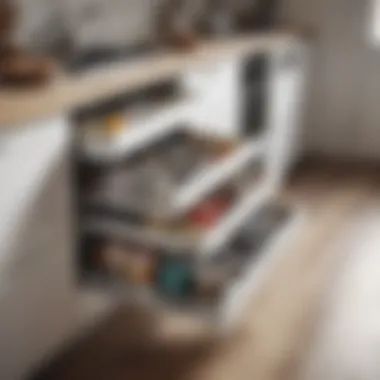
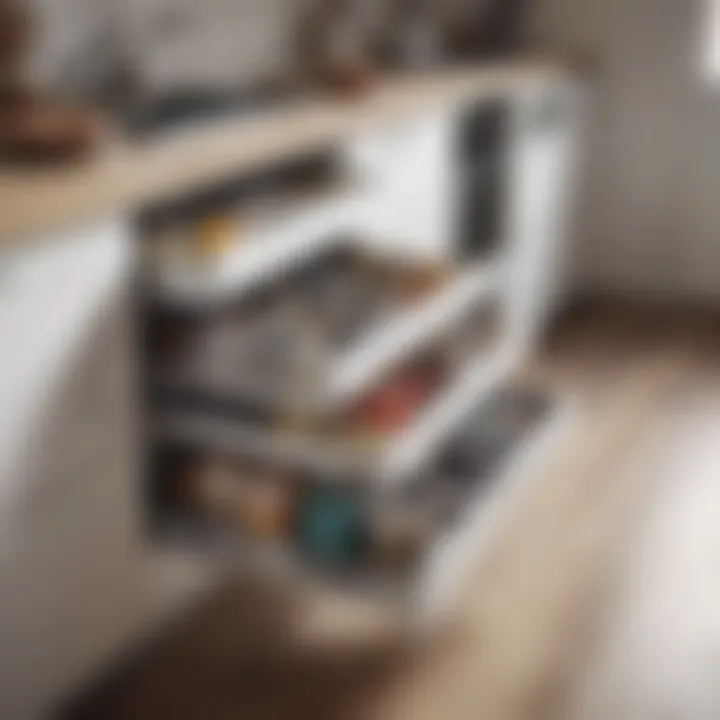
Intro
When it comes to kitchen design, efficient use of space is paramount. Pull-out kitchen shelves have emerged as a game-changer for homeowners striving to maximize their kitchen’s functionality. These clever installations not only add an element of modernity to your kitchen but also serve practical purposes that can streamline your daily cooking activities. Imagine trying to reach that elusive pot at the back of a deep cabinet; it’s a situation many can relate to. With pull-out shelves, everything is just a quick tug away, making meal prep less of a chore and more a joy.
In this article, we will explore the myriad ways pull-out kitchen shelves can enhance both efficiency and organization within your culinary haven. We’ll dive into current trends in furniture design that pair beautifully with these features, examine the practical considerations in choosing the right shelves, and provide tips for maintaining them to ensure they stand the test of time. Understanding these elements can empower homeowners, interior decorators, and DIY enthusiasts to elevate not only the functionality but also the aesthetic appeal of their kitchens.
Furniture Design Trends
Being aware of the current design trends can help you make choices that reflect not just functionality, but also your personal taste. Pull-out kitchen shelves fit snugly within a wider aesthetic and their design can set the tone of your kitchen.
Current Styles and Themes
In recent years, minimalism has taken center stage, infusing kitchens with clean lines and uncluttered surfaces. Pull-out shelves complement this aesthetic perfectly. Sleek and simple designs are favored, particularly those that are easy to access and use without compromising the overall clean look. Think of open shelving that you can pull out without making it feel cluttered. Moreover, rustic styles remain enduringly popular, with pull-out features crafted from reclaimed wood lending warmth and character. Mix and match styles can create a truly personalized space, where the practicality of pull-out shelves meets an eclectic vibe.
Color Palettes and Materials
The materials you choose for your pull-out shelves can significantly affect the overall kitchen appearance. Laminated surfaces in neutral tones fit nicely into most color schemes while providing durability. Meanwhile, natural woods bring warmth to the space and can be enhanced with oil finishes that guard against moisture. Bold colors can be used as accents; for instance, navy blue pulls can contrast strikingly against light-colored cabinets. Moreover, incorporating metal components, such as stainless steel or brass, can yield a sophisticated, modern touch that works wonders in contemporary kitchens.
"In choosing materials and colors, remember that every detail counts. A small thing like the material of pull-out shelves can transform the ambiance of your kitchen."
Practical Furniture Tips
The purchase and installation of pull-out shelves can seem daunting, yet with the right guidance, it doesn’t have to be complicated. Here are key points to ensure you make the best choice for your kitchen.
How to Choose the Right Size
Determining the proper size for your pull-out shelves is crucial. First off, measure your available space carefully. Too wide or too narrow can lead to frustration later on. It’s also worth considering what you intend to store. If you’re looking to hold large pots or appliances, deeper shelves might be your best bet. On the flip side, shallow shelves work wonderfully for spices and canned goods. Opt for adjustable shelving if you need a versatile solution that can grow with your needs.
Maintenance and Care for Longevity
Caring for your pull-out shelves is essential, as good maintenance can extend their lifespan. Regularly check the slides and tracks for any debris or dirt. A quick wipe-down with a damp cloth can keep things spick and span. Additionally, consider applying a protective coating if the wood is exposed to moisture. If you notice any issues like squeaking or sticking, quick lubrication can do the trick. Keeping these shelves clean and functional not only allows for easy access but also contributes to the overall perception of your kitchen’s upkeep.
Embracing the benefits of pull-out kitchen shelves means you're not just investing in storage – you're elevating your entire kitchen experience. The thoughtful integration of these shelves into your kitchen remodel can enhance usability and decor, making the heart of your home feel both functional and stylish.
Understanding Pull-Out Kitchen Shelves
Pull-out kitchen shelves have become a pivotal element in modern kitchen design, exemplifying both functionality and efficiency. In today’s world of open-concept spaces, maximizing every nook and cranny has risen to the top of homeowners' priorities. Pull-out shelves provide an ingenious solution to the nagging problem of inaccessible storage. Their primary role is to bring the items you need right to your fingertips, effectively transforming how you interact with your kitchen.
When discussing pull-out kitchen shelves, we acknowledge a few critical aspects that make them indispensable. Take convenience, for example. Traditional cabinets often leave you fumbling in the dark recesses, finding yourself face to face with an avalanche of cookware or canned goods. On the other hand, pull-out shelves let you slide those items into view with a simple tug, enhancing overall usability while minimizing wear and tear on your body—a major win for avid cooks and bakers alike.
Definition and Purpose
Pull-out kitchen shelves are sliding shelves that are designed to fit into existing cabinetry. They operate on rails, which allow them to glide in and out smoothly. The overall purpose is straightforward: to increase accessibility to items stored in cupboards. Think of them as the kitchen's way of extending a helping hand. Instead of battling with deep shelves where things tend to hide, you gain the ability to fully utilize your storage space without strain.
Benefits of Pull-Out Shelves
The advantages of pull-out shelves extend far beyond mere convenience. They significantly enhance the kitchen's functionality and organization. Here’s a closer look at the benefits:
Enhanced Accessibility
Enhanced accessibility stands tall as a defining benefit of pull-out shelves. Instead of bending, reaching, or stretching, you have quick, easy access to what you need. Items slide out smoothly, eliminating the frustrations that come with reaching into deep cabinets. This characteristic makes them a hit among the elderly or those with mobility challenges, as they can retrieve items without unnecessary strain. Plus, it reduces the chances of food waste—who hasn't lost a jar of something at the back of the cabinet only to find it months later?
Their unique feature lies in its thoughtful design that caters directly to ergonomics. A prime example is a pull-out spice rack that lets you see every jar at a glance, making meal prep straightforward and enjoyable.
Maximized Storage Efficiency
Next up is maximized storage efficiency. Pull-out shelves allow you to fully utilize the vertical space of your cabinets without obscuring visibility. Everything from stacks of dishes to canned goods fits snugly while remaining easily accessible. The shelves can even be adjusted, allowing for a variety of configurations depending on what you store. This adaptability means fewer wasted spaces and more organized storage, giving you that sense of order we all crave in the kitchen. Their clever design helps to eliminate clutter, revealing not just items but also their placement, thereby simplifying your cooking routine greatly.
Improved Organization
Last but not least is the aspect of improved organization. With pull-out shelves, it's far easier to categorize kitchen items and maintain order. Imagine grouping all your baking sheets, pots, and pans in one accessible location. Instead of digging around, everything is laid out in front of you—what a relief!
This systematic arrangement fosters a pleasant cooking environment and saves valuable time when preparing meals. It assists in establishing a sense of control over your kitchen space, which translates to a more enjoyable culinary experience overall.
"A well-organized kitchen is not just about aesthetics; it's about making your life easier and more efficient."
In summary, understanding pull-out kitchen shelves is vital as it encompasses their definition, purpose, and the myriad benefits they offer. They contribute significantly to enhancing kitchen functionality, promoting ease of use, and maintaining a well-ordered environment. This lays a robust foundation for making informed decisions about integrating them into your kitchen.
Key Factors in Choosing Pull-Out Shelves
Choosing the right pull-out shelves is more than just a matter of preference; it's a decision that can have lasting implications for the usability of your kitchen. These shelves can turn a cluttered cabinet into a beacon of efficiency. Understanding the various key factors at play can ensure you make a wise investment that suits both your practical needs and aesthetic desires.
Material Considerations
Wood vs. Metal
When it comes to making a choice between wood and metal for your pull-out shelves, both have their unique merits. Wood tends to give a warmer, more traditional feel to any kitchen. It's sturdy, can bear ample weight, and offers customization options like staining or painting to match your decor. On the flip side, metal is often lauded for its sleek, modern appearance and high durability. It's resistant to moisture, which can be a blessing in busy kitchens.
It's essential to weigh the pros and cons:
- Wood: Elegant, easily customizable, but may be more susceptible to water damage if not treated properly.
- Metal: Modern look, excellent durability, often more expensive, and can feel cold or industrial in a home setting.
In short, the choice between these materials may come down to style, desired durability, and how you plan to use the shelves.
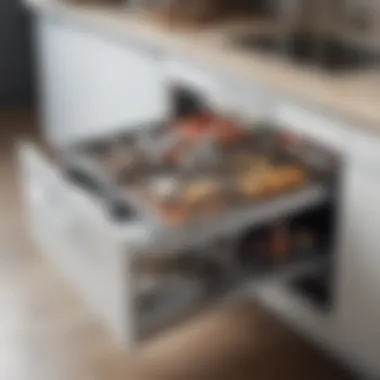
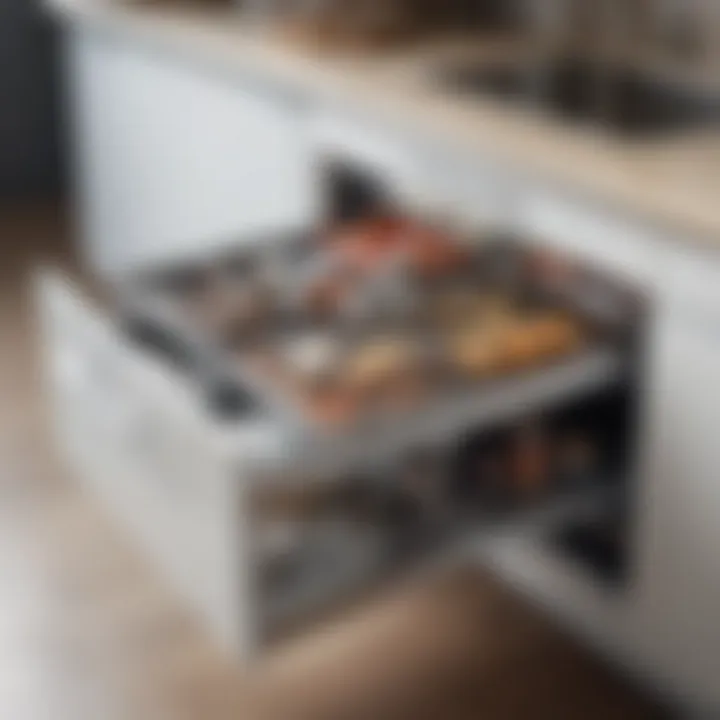
Durability and Weight Capacity
The durability and weight capacity of pull-out shelves are critical factors. Shelves made from robust materials can typically withstand heavier items, from big pots to stacks of plates, without sagging. Opting for high-quality materials ensures the shelves maintain their structural integrity over time.
Consider these points when shopping:
- Durability: Choose materials that can resist wear and tear, especially if the shelves will hold numerous kitchen items.
- Weight Capacity: Assess how heavily you plan to load the shelves. Most manufacturers specify maximum load limits, which are worth paying attention to.
Striking a balance between these two aspects ensures that you won't frequently worry about the stability of your kitchen storage.
Size and Dimensions
Standard Sizes
Standard pull-out shelf sizes are convenient, offering a go-to solution for many homeowners. They generally allow for quick installation since they fit most existing cabinetry without needing significant adjustments. This ease of use makes them a favored choice among who just want to improve functionality without delving into too much customization.
However, these standard options might not fit every kitchen layout perfectly. They usually come in fixed sizes, which could mean leaving some space unused or requiring additional modification for an awkward fit.
Custom Options
For those who are feeling a little more adventurous, custom options might be the way to go. Custom dimensions allow you to optimize every inch of your kitchen, especially if you have irregular cabinet sizes or unique furniture layouts.
Custom shelving offers benefits, such as:
- Tailored Fit: Every shelf can fit snugly into its intended space, maximizing storage potential.
- Unique Designs: You can choose to create something that stands out aesthetically.
Though often more expensive than standard sizes, they may ultimately save you money by utilizing space more efficiently.
Design Aesthetics
Styles to Complement Your Kitchen
The styles of pull-out shelves can greatly influence your kitchen's overall appearance. From minimalist designs to more elaborate, ornate setups, finding a style that complements your existing kitchen decor is crucial for creating a harmonious space.
Some popular styles include:
- Modern: Clean lines and sleek finishes for a contemporary vibe.
- Traditional: Detailed craftsmanship that adds character, usually made from wood.
The right style can make a significant impact, ensuring that the shelves are not just functional but also enhance the visual appeal of your kitchen environment.
Finishes and Colors
Finishes and colors are critical to aesthetic appeal when selecting pull-out shelves. Options range from rich, dark woods to bright and airy whites. Finishes can either create a stunning contrast or blend seamlessly into your kitchen's overall palette.
Key considerations are:
- Finish Type: Matte vs. glossy can change a shelf's overall look drastically. A glossy finish might reflect more light and feel more modern, whereas a matte finish can add a touch of coziness.
- Color Choices: Picking the right color can tie the entire kitchen together or provide a standout feature to highlight the shelves.
Ultimately, the finishes and colors selected complement the core design of your kitchen, ensuring that they serve as assets instead of afterthoughts.
Installation of Pull-Out Kitchen Shelves
Installing pull-out kitchen shelves is a game changer when it comes to maximizing the functionality and organization of any kitchen space. It’s not just about shoving a few planks into a cabinet; this installation process can dramatically alter how one interacts with the kitchen, allowing easy access to items that would otherwise remain out of reach. The right installation can enhance the usability of the space while also boosting aesthetic appeal.
Preparation and Planning
Measuring Available Space
Measuring available space is a fundamental first step in the installation of pull-out shelves. Having the right dimensions ensures that the shelves fit snugly without overcrowding the existing kitchen layout. Take a moment to measure the height, width, and depth of your cabinets. This isn’t just a sideline task; it’s crucial. If you get it wrong, the whole project can feel like a house of cards come crumbling down.
The key characteristic of measuring space is precision. Every kitchen is unique, and accurate measurements can eliminate a world of hassle later on. One unique aspect of this process is the capability to visualize how the new shelves will integrate with existing elements like plumbing and electric outlets. The advantage here is twofold: it guides your selection of shelves and minimizes potential installation headaches further down the line.
Assessing Structural Support
Assessing structural support is equally important and often overlooked. A pull-out shelf might look sturdy on its own, but if it’s not secured to a solid framework, it could spell disaster. When contemplating this, one should consider underlying frameworks, like cabinet sides and floor support. Ensuring that these are intact and supportive can save you from future frustration.
Essentially, the hallmark of checking structural support is stability. A well-supported shelf not only carries weight efficiently but also adds to the confidence users feel when pulling them out. A unique feature is that sometimes adjustments in cabinet anchoring may be required, which could mean rearranging other elements slightly. The downside is this could add a smidge to the time investment upfront, but trust me, it’s worth it.
Step-by-Step Installation Process
Gathering Necessary Tools
Gathering necessary tools isn’t just about grabbing a hammer and some nails; it’s about assembling an arsenal essential for a well-done job. Depending on the shelf type, you might need screwdrivers, levelers, and measuring tapes. Familiarizing yourself with these tools can make the installation smoother and more satisfying.
What sets this stage apart is thoroughness. Knowing what’s needed helps eliminate interruptions mid-project, which can lead to lapses in focus. One unique aspect is that some modern pull-out shelves come with specific hardware requirements. Missing a crucial tool could lead to delays. This aspect proves a blend of preparation and foresight, considering long-term functionality.
Installing the Hardware
Installing the hardware requires a careful touch and some finesse. Once you've measured and labeled where the shelves will reside, it’s time to attach all components to the cabinetry. The focus here is on getting the installation just right; uneven hardware can lead to wobbling shelves, and nobody wants that.
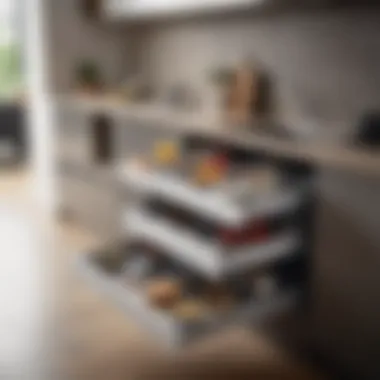
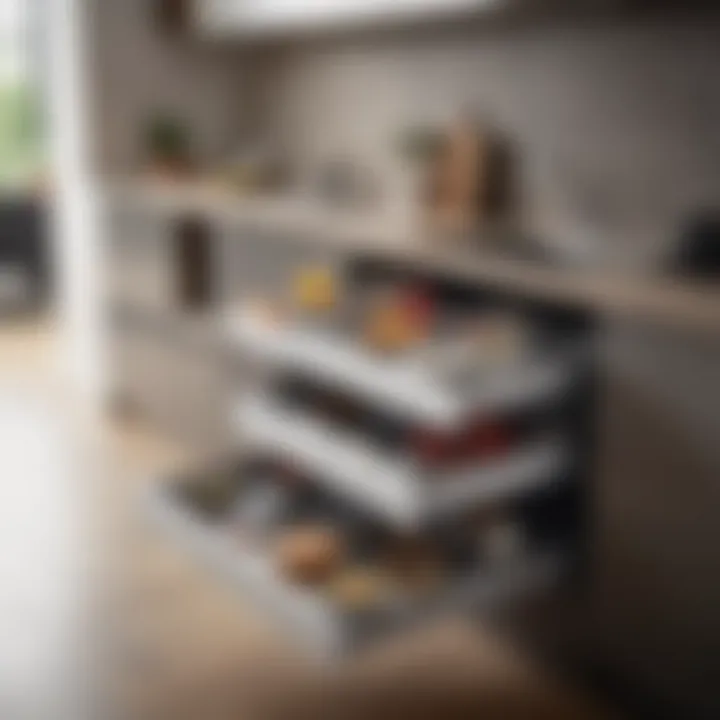
The defining characteristic of this step is its meticulous nature. Properly aligned components not only ensure that the shelves function well but also enhance durability. One interesting feature of hardware installation is that many kits now come with guides. While instructions should always be followed, having those visual aids can sometimes make a world of difference. Make sure to double-check if all fittings are secure—it’s easier to fix things in this stage than post-installation.
Securing the Shelves
Securing the shelves is perhaps the most satisfying part of the installation process. Once everything is in place and adheres well, the last step is to ensure that they can stand the test of daily use. This entails checking that the slides work smoothly and making any necessary adjustments to achieve the perfect alignment.
What makes this step stand out is the satisfaction of seeing your effort come to fruition. Secure shelves can carry kitchen items from spices to larger appliances without any worry. However, a word of caution: Overloading shelves can lead to mishaps. Balancing weight across shelves is a unique feature to keep your installations looking new for years to come. It’s a fine balance—but one worth managing effectively.
Professional Installation vs. DIY
In the end, one faces a choice: enlist professional help or go for a DIY installation. Each route has its pros and cons. Choosing to hire a professional may save time and effort, but it could also come at a premium. On the other hand, a do-it-yourself approach lets you take control but requires a steep learning curve.
Thinking about the benefits of each option might simplify the decision. For DIY enthusiasts, the pride in personal handiwork can be rewarding. For those who prefer streamlined efficiency, hiring a professional may allow for a smoother installation experience. Remember, it all boils down to comfort level and long-term goals.
Maintenance and Care of Pull-Out Shelves
Pull-out kitchen shelves are an ingenious way to enhance your kitchen’s functionality. However, maintaining them goes beyond just wishing they work properly. Regular maintenance and care not only extend the lifespan of these shelves but also ensure they continuously serve their purpose effectively. By investing some time in their upkeep, home and kitchen will remain efficient and clutter-free.
Cleaning Techniques
Material-Specific Cleaning Products
The choice of the right material-specific cleaning products can greatly affect the maintenance of pull-out shelves, especially since these are often subjected to spills and dirt from regular kitchen use. For wooden shelves, products that are oil-based or specifically made for wood are ideal; they nourish the wood while avoiding excessive moisture that might warp it. On the other hand, metal shelves benefit from non-abrasive cleaners that prevent scratches, preserving their shiny appeal.
A significant aspect is that these cleaners are usually designed to target grime without damaging the surface. For instance, natural wood cleaners often contain oils that enhance the look while providing a protective barrier. This feature not only keeps the wood looking good but also extends its durability.
However, it’s important to be cautious; using the wrong cleaner can be a recipe for disaster, leading to damaged finishes or a dull appearance. Hence, the specialized nature of these products ensures your shelves remain in tip-top shape.
Regular Maintenance Practices
Part of the charm of pull-out shelves is their convenience. To keep them functioning smoothly, implementing regular maintenance practices is critical. This includes routinely checking for loose screws, which can compromise stability. Tightening them can prevent unwanted accidents, ensuring everything stays intact.
Additionally, cleaning track areas of the pull-outs helps prevent sticky situations. A quick wipe-down with a damp cloth can do wonders, preventing dust build-up that may cause sliding issues over time. This simple action is non-intrusive yet significant, ensuring that the mechanism remains functional.
One unique feature of regular maintenance practices is that they promote hygiene. With periodic cleaning, you remove residues that attract pests, keeping your kitchen not just organized but also healthy. The downside? You might need to carve out a tiny bit of time for these activities, but the long-term benefits far outweigh any inconvenience.
Troubleshooting Common Issues
Sticky Slides
Experiencing sticky slides can be frustrating and impede the ease of accessing your kitchen items. This issue often stems from a build-up of food particles, grime, or even lack of lubrication. Regular usage without maintenance can cause the sliding mechanisms to become sluggish, thus not fulfilling their intended purpose.
The benefit of addressing this issue promptly is clear. By simply cleaning and lubricating the slides, you can ensure the shelves function smoothly for years to come. A unique aspect of sticky slides is that they are often symptomatic of deeper issues. Ignoring them may lead to more significant mechanical failures down the road.
A downside, however, could be the initial effort required to identify if there are deeper problems at play. But recognizing and promptly addressing sticky slides can save you both frustration and potential repairs later on.
Uneven Shelves
Uneven shelves can throw a wrench in the organization of pull-out spaces, making everything from food items to cooking tools difficult to store and retrieve. The cause of this problem may vary from improper installation to weight distribution across the shelves. Noticing the unevenness early can mitigate chaos in your kitchen.
However, troubleshooting can be beneficial in two ways: first, it allows for potential adjustments to be made, ensuring that everything is level. Secondly, this situation encourages a check-up on what’s really in those shelves, prompting organization based on actual need rather than what was haphazardly stuffed in.
In addressing this issue, keep in mind that factors such as load capacity should be checked, ensuring that the shelves are not overloaded, which could lead to future concerns. The unique opportunity presented by dealing with uneven shelves is that it can lead to better organization habits and overall functionality.
"Regular maintenance and care are not just tasks; they are investments in the long-term efficiency and aesthetics of your kitchen space."
Innovative Designs and Trends
The landscape of kitchen design is ever-evolving, and pull-out kitchen shelves are no exception to this progress. This section explores how innovative designs and current trends influence the functionality and appeal of these storage solutions. As modern lifestyles demand more efficiency in our homes, particularly in kitchens, the need for functional, stylish, and space-saving solutions is substantial. By integrating innovative designs and sustainable practices, homeowners can enhance their kitchen environments while making conscientious choices.
Modern Pull-Out Shelf Designs
Pull-out shelves are taking on exciting new forms. Two particularly noteworthy designs are multi-tiered shelves and hidden compartments, each with unique features and advantages that contribute to efficient kitchen organization.
Multi-tiered Shelves
Multi-tiered shelves offer a layered approach to storage, allowing users to maximize the space available in their cabinets. This design facilitates not just stacking items but organizing them by category, making retrieval quick and efficient. A major characteristic of multi-tiered shelves is their flexibility; they can be adjusted to fit various items, from spices to bulky pots, optimally utilizing vertical space.
The unique feature of multi-tiered shelves is the tiered design, which allows for better visibility. No more digging through dark recesses to find that elusive spice jar! Instead, everything is in sight. This has become a popular choice because it promotes organization and reduces clutter.
However, they do have a disadvantage. If overstuffed, the shelves can become cumbersome, potentially hindering the ease of access. Despite this, the benefits often outweigh the downsides, making multi-tiered shelves a smart addition to any kitchen looking for a functional upgrade.
Hidden Compartments
Hidden compartments bring an element of surprise and efficiency to kitchen design. The idea of using concealed spaces is not just about aesthetics but maximizing functionality. These compartments cleverly disguise items that can often clutter counters, providing a seamless look.
One key characteristic of hidden compartments is their ability to store less frequently used items out of sight while still keeping them easily accessible. This makes kitchens appear larger and more organized, stripping away unnecessary distractions and chaos.
A unique feature of hidden compartments is the soft-close mechanism, often incorporated for smooth transitions that add a touch of luxury to everyday tasks. While they offer wow-factor and sleekness, on the flip side, the installation could be a bit more complex than traditional shelves. Homeowners might need a professional's help to ensure proper functionality.
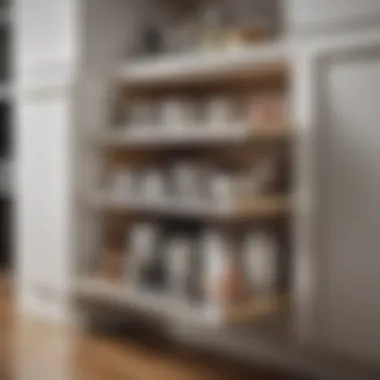
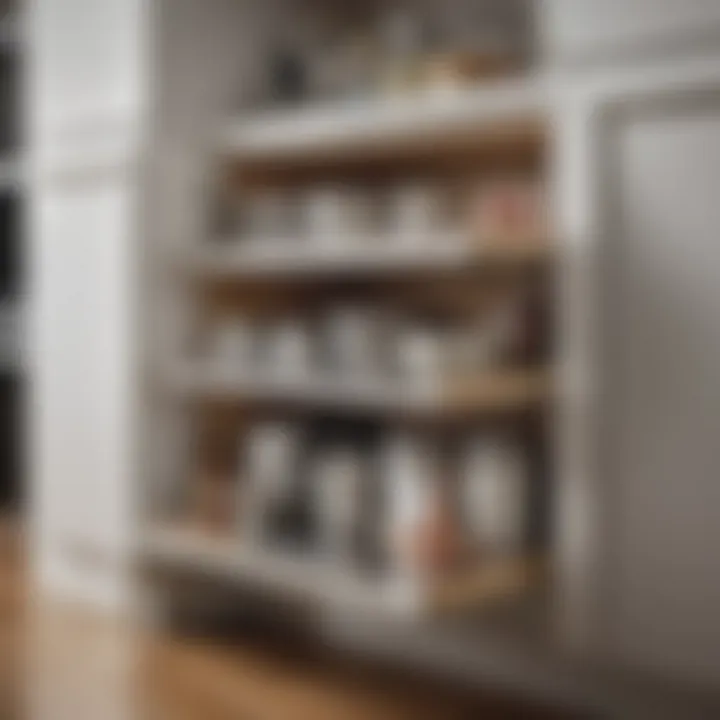
Sustainable Materials and Practices
Shifting gears to sustainable practices—today’s consumers are increasingly aware of their choices’ environmental impacts. When incorporating pull-out shelves, materials matter. Eco-friendly choices and the use of recycled materials are not just trends; they are pivotal in shaping a responsible approach to design.
Eco-friendly Choices
Eco-friendly choices in materials focus on minimizing harm to the environment. This aspect is important as homeowners seek to balance beauty, function, and responsibility. Materials like bamboo, known for its rapid regrowth, and formaldehyde-free plywood present excellent options that not only hold up in terms of durability but also help reduce a home’s carbon footprint.
These materials often showcase natural textures and colors, providing a warm and inviting feel in kitchens without the added chemical treatment found in many conventional woods. A significant advantage is that they are often sturdier, standing the test of time and minimizing the need for replacements.
On the other hand, they may come with a higher price tag initially, and some consumers might be hesitant to invest more upfront. However, considering their long-term value and impact encourages many to rethink their kitchen renovations with a more sustainable perspective.
Recycled Materials
Recycled materials offer another avenue for eco-conscious homeowners. By utilizing materials that have had a previous life, such as reclaimed wood or repurposed metals, these shelves not only tell a unique story but also promote sustainability in an aesthetic way.
This is a popular choice among decorators who want to infuse character into kitchens while being mindful of their choices. The distinctive look of recycled materials can add charm and warmth to a kitchen that mass-produced items may lack.
However, one challenge with recycled materials is ensuring quality. The variability in texture and finish means that sometimes a perfect match isn’t possible—this can also drive design challenges. Nonetheless, for many, the beauty of these materials far outweighs any consistency issues, leading to a kitchen that is both practical and appealing.
Cost Implications
Understanding the cost implications of pull-out kitchen shelves is crucial for anyone looking to enhance their kitchen's functionality without breaking the bank. This section sheds light on various cost-related aspects, including material expenses, installation charges, and the long-term value these shelves can offer. When planning a kitchen renovation or upgrade, homeowners must weigh these elements to make informed financial decisions.
Material Costs
When it comes to pull-out shelves, the choice of materials can significantly impact the overall expense. Wood and metal are the most common choices, but the type of wood can vary from budget-friendly particleboard to premium hardwoods, like oak or maple. While particleboard may suffice for lighter use, investing in hardwood may pay off since they typically last much longer.
Consider these points regarding material costs:
- Wood: Priced variably, depending on the species. Birch or maple offers durability but tends to be on the expensive side.
- Metal: Stainless steel, while a bit pricier, adds a modern flair and easier maintenance.
- Eco-friendly Options: Recycled or sustainably sourced materials can have added costs but contribute to green practices.
"Investing in better materials often leads to fewer headaches down the road."
With this in mind, think carefully about how much stress your shelves will undergo and choose a material that suits your needs well.
Installation Expenses
Next in line is the cost of installation. Homeowners can typically choose between hiring a professional or embarking on a DIY journey. Each option comes with its unique price tag:
- Professional Installation: This can vary widely based on location, the installer’s expertise, and the complexity of the installation. Expect to pay anywhere from $100 to $400.
- DIY Installation: If you're skilled and willing to put in the effort, you could save a chunk of change. However, consider potential costs for tools or materials needed for the installation process, including screws and brackets.
Make sure to assess whether you have the right tools before diving in. Besides, keep in mind that improper installation can lead to frustrations down the line, such as uneven shelving or common issues like sticky slides.
Long-term Value Consideration
The long-term value of pull-out shelves deserves attention, especially when pondering their costs. Though the initial investment might seem steep, consider it against the time and headaches saved through easy organization and accessibility.
Here are several points highlighting their long-term benefits:
- Enhanced Usage: Efficient use of space often leads to better functionality in the kitchen, allowing homeowners to store more items without clutter.
- Durability: Higher-quality materials typically mean a longer lifespan, with minimal wear and tear over time.
- Increased Home Value: A well-designed kitchen often translates to higher home resale value, as potential buyers appreciate functionality and modern upgrades.
When planning your budget, keep in mind that investing in high-quality pull-out kitchen shelves may lead to increased satisfaction and usability in the future.
In sum, thorough consideration of the material, installation approaches, and long-term benefits can guide your spending, ensuring that your kitchen remains as functional as it is aesthetically pleasing.
Finale and Final Thoughts
As we draw the curtain on the discussion around pull-out kitchen shelves, it's essential to grasp the core offerings such enhancements bring to the kitchen landscape. These shelves are not just mere additions to cabinetry; they represent a philosophy of maximizing space and elevating functionality to newfound heights.
When integrated thoughtfully into a kitchen, pull-out shelves can transform cluttered areas into efficient workspace hubs. Their ability to enhance accessibility ensures that everything is within arm's reach, which is crucial for homes where speed and efficiency are paramount. Household activities, from meal prep to cleaning, become less of a chore when the right tools and ingredients are easily accessible. Beyond mere utility, these shelves also contribute to overall kitchen aesthetics. A well-organized space can evoke a sense of calm and order, fostering a welcoming environment for family and guests alike.
Moreover, the value proposition cannot be overstated. With the right investment in quality materials and design, homeowners can expect longevity and reduced wear and tear on cabinetry. It's a cost-effective way to boost your home's value, making these shelves a wise choice for the pragmatic homeowner.
"By marrying aesthetics with functionality, pull-out shelves invite you to rethink what your kitchen can truly be."
In the end, understanding the integral nature of this feature in kitchen design may inspire individuals towards thoughtful creativity in their spaces, tailoring their environments to suit their unique needs.
Summarizing the Benefits
To recap, the advantages of incorporating pull-out kitchen shelves are numerous. They can dramatically improve your kitchen’s functionality through:
- Enhanced Accessibility:
Easy reach fosters a smoother cooking process and better organization of kitchen items. - Maximized Storage Efficiency:
Pull-out shelves utilize every inch of space, making them far superior to traditional shelving methods. They can accommodate larger pots and pans that might otherwise sit wedged in the back. - Improved Organization:
Grouped items make it quicker to find what you need, removing the hassle of digging through clutter.
Reflecting on these benefits, it’s clear that pull-out shelves do not just offer quick fixes but provide comprehensive solutions.
Encouraging Thoughtful Implementation
Installing pull-out shelves is not merely about fitting them into a kitchen. It’s a chance for homeowners to embrace innovation in personalizing their culinary spaces. As such, it is critical to approach this enhancement with careful planning and foresight.
Start by taking stock of your specific needs. What items do you use most often? How often do you cook? Should your pull-out design accommodate heavier items?
Here are a few pointers to guide your implementation:
- Tailor to Your Space:
Think about the dimensions of your kitchen. Are you utilizing awkward corners? Custom pull-outs can be crafted to fit these snug spaces, ensuring nothing goes to waste. - Prioritize Quality:
Opt for durable materials that will stand the test of time. It’s better to invest a bit more upfront than to face frequent repairs or replacements later. - Design with Flow in Mind:
Consider the kitchen layout. Positioning shelves near the prep area can streamline your cooking process, making the overall kitchen workflow much more intuitive. - Regular Assessment:
Once installed, revisit your setup quarterly. Are your storage solutions still fulfilling your needs? It might be the perfect time to shuffle the layout or modify what’s stored within.
By embracing these transformative elements, homeowners can effectively elevate their kitchens into functional masterpieces that reflect personal style while enhancing everyday convenience.



